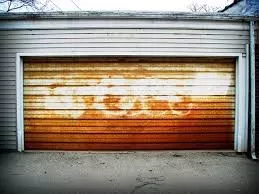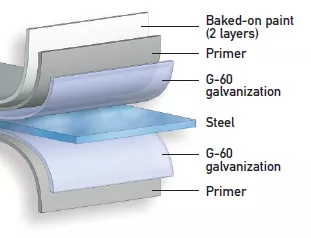Have you noticed that you are finding rust spots on your garage door? This can be a frustrating situation, especially if your garage door isn’t very old. You might wonder why the high-quality paint on the door doesn’t offer more protection.
The first thing you want to consider is where the garage door is located in terms of the environment since that can lead to rust. After you have an understanding of what the risks are, you can take steps to avoid problems in the future. We’ll explain exactly what we mean below!

Take in the environment of your home
One of the most important things to take into consideration is the environment where you live. Think about whether you live somewhere coastal where salt air is more likely to contact your garage door, or you are close to the street and the salt used for de-icing might build up on the door. Maybe you are located in the mountains in an industrial area where materials are stored. You may be in a much less intense environment, but all of these exist and garage door specialists are tasked with helping customers who have issues in these areas and others, including a garage door that has started to rust.
One of the things that can lead to the look of rust is very benign. During the spring and summer months, a coating of pollen from white or yellow birch trees may cause an appearance of rust. The streaks left on the door after pollen touch it can look a lot like rust, but they are not.
Be aware of the paint type on your garage door
Another thing that has to be thought about is what sort of paint is on your garage door. In most cases, North American garage doors have primer applied, followed by a baked-on coat of paint. On top of that, the steel used to manufacture the doors contains some amount of zinc which helps protect against rust. This is taken so seriously that DASMA (the association of North American garage door manufacturers) has specific standards relating to how thick the coating should be to galvanize steel and prevent unnecessary rusting.

It’s also important to be aware of whether the garage door has been repainted in the past by the previous homeowner, a specialized company, or yourself. What sort of paint was used and how it was applied are also crucial pieces of information to have.
But you also need to be aware that if the galvanized steel or the protection paint finish on top of it have been damaged through a puncture or piecing, this makes the protection useless. You can think of this like a car that was in an accident which left a puncture, so metal is exposed. In order for the car to avoid rust, it has to be repaired to prevent the issue.
It’s important to keep your door clean
If you aren’t sure when the last time was that the garage door was cleaned, it’s probably time. We recommend you do it at the same time as you wash your car. This helps remove any dirt and/or debris that would otherwise build up on the door. It can also uncover any oil or grease stains you may not know about. If there are spots of grease underneath, this is often attributed to when you may have over-lubricated the drive chain connection to your garage door opener. Keep in mind that white grease should only be applied when required.
When you are ready to clean your garage door, you can use the exact same soap as you would for your vehicle. Liquid dishwashing detergent is another great alternative if you do not have soap made specifically for automobiles. Many of them offer a degreaser, which is a helpful addition. One thing to avoid - the use of a pressure washer. If your garage door paint is breaking down, this can create even more problems by removing the outermost layer of paint. Instead, take out a garden hose with a medium setting nozzle to clean off the surface.
How to handle any rust spots on the garage door
Not sure if the spots on the door are rust? Look for tiny dots that might resemble particles of brown like if a grinder was used to cut steel and bits of it became embedded in the door surface. Most of the time, you will find rust on the lowest or next to lowest sections of the door. Those who have a door near the street may notice these dots are actually caused by a combination of abrasives, wet snow, and street salt which are used on the street. These can deposit on the door and cause issues.
For surface rust stains, you can follow a few steps to handle the issue. You want to use a mild product to start. You can dilute water and vinegar in a plastic spray bottle in equal proportions before spraying down the area and then wiping it off with a fresh cloth. If that doesn’t fix the issue, try using something with an abrasive. You can use a small bowl to create a paste of water and baking soda. Take the past and spread it on the surface then let it sit there for about 30 minutes. You can wipe it off with a cloth and then rinse the residue. The same cleaner you use on your bathroom tile is another excellent choice. Spray it onto the garage door, let it sit for a while, wipe, and then rinse with water.
Schedule washing your garage door twice a year
Do you live in a location where air pollution is fairly bad? If so, you should mark your calendar to ensure you wash your garage door twice a year at a minimum. We recommend washing it once in the fall and again in the spring of each year. As we mentioned, an easy way to do this is to wash the door at the same time as your car. If you really want to go above and beyond, you can protect it with liquid wax just like your vehicle, too.
To better learn how to properly care for your garage door, you can try the recommendations in Garaga’s maintenance guide. Sure, it might take a little effort, but the results will be well worth it.
Are you thinking about swapping out your garage door?
For those who are located in or near Saint John and Fredericton who are ready to retire their old garage door for a shiny, new one, you can contact us now.








Add new comment